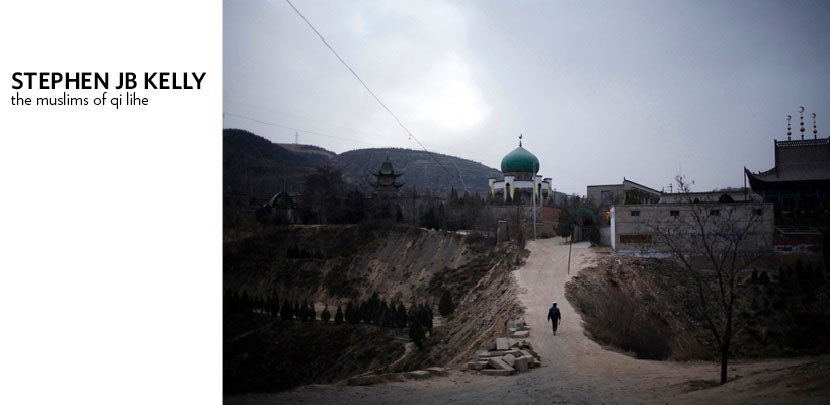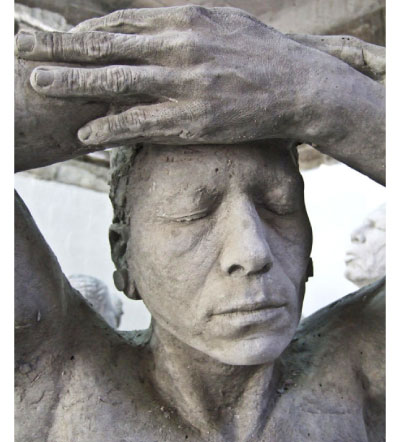
Photography courtesy of Jason deCaires Taylor

Underwater sculpture is an environmental art form invented by British diver and sculptor Jason deCaires Taylor, who is now hard at work creating more than 400 life-size sculptures that will form the world’s largest underwater sculpture museum. Located off of Cancun — Mexico’s largest tourist destination — the waters where the sculptures are located are visited by over 750,000 people each year.
Taylor’s sculptures are made of environmentally safe materials that encourage reef regrowth, and located on the ocean floor in areas that won’t harm existing ecosystems, thus allowing the much-damaged coral to regrow and create whole new ecosystems to support fish, crustaceans, and other invertebrates. The eery underwater presence of the life-size human sculptures involved in various activities (reading the paper; lounging in underwater gardens; maintaining an archive of messages in bottles) serves to distract the tourists, whose dives have thus far only worked to harm the Caribbean reefs, in order to prevent them from doing further damage.
(more…)

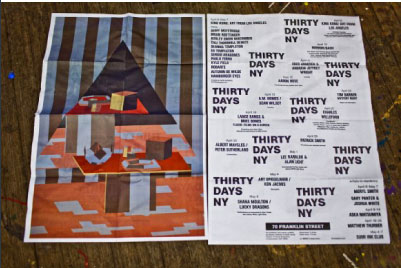
Thirty Days Opening Night: Photography by Brian Derballa


Last Thursday saw the riotous opening party — complete with psychedelic light show — of Thirty Days NY, an event series in a pop-up space in Tribeca. Curated by David Jacob Kramer and Sammy Harkham (LA natives might recognize them as the minds behind the Family Bookstore, a curated collection of published works of art, text, design, and performance), the project mashes together incredible artists, writers, and thinkers from all walks of life — and offers all events for free and open to the public. This past weekend, performances by Sonic Youth’s Kim Gordon and Thurston Moore and even Fred Armisen of SNL fame gave us an enticing taste of the caliber of talent slated to appear in the weeks to come.
Highlights of the program include A.M. Homes reading Sean Wilsey; Art Spiegelman in discussion with experimental filmmaker Ken Jacobs; a presentation by Aaron Rose of never-before-seen VHS short film footage by the artists he represented in the heyday of his legendary New York gallery; psychedelic light shows by Joshua White — who invented the shows in the sixties and performed at New York’s infamous Fillmore East with the likes of Jimi Hendrix, Janis Joplin, and The Doors — together with Gary Panter, who built the sets for Pee-wee’s Playhouse in the ’80s.
(more…)

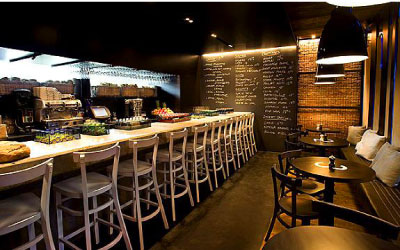


Here to fill a heretofore unnoticed gap in the New York dining scene is Tartinery, a modern twist on the classic Parisian bistro. Unlike your typically upscale French restaurant, as its main fare this casual spot in Nolita offers up various versions of the tartine — a delicious, delicate open-faced sandwich made of thinly sliced bread topped with various gourmet spreads and garnishes. Founded by three French friends who sorely missed their tartines, Tartinery has partnered with the well-known French bakery Poilâne in order to serve their patrons only the most authentic of these Parisian snacks. Visitors can dine on salads, soups, freshly-squeezed juices, and, of course, a selection of exquisite French wine to round out the meal. Complete with a living tree, oversized fireplace and quirkily numbered tabletops, Tartinery successfully combines the casual-yet-gourmet feeling of your typical bistro in Paris with the tweaks and adornments that make dining in New York City a unique culinary experience.
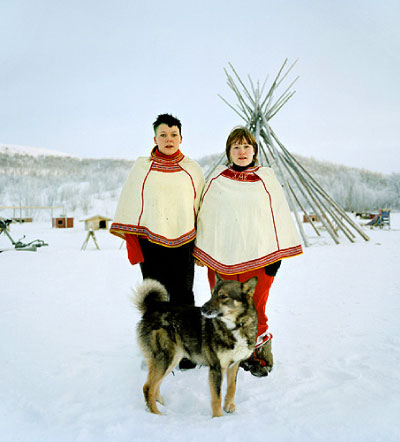
Photography by Céline Clanet courtesy of Céline Clanet

Céline Clanet was born in 1977 in the French Alps, leaving only at 18 to study photography at the Ecole Nationale de la Photographie in Paris. She has since produced series upon series of evocative images documenting her obsessive explorations of place, identity, death, and memory. Currently, Clanet has a stunning show on display until April 4 at the Pohjoinen Valokuvakeskus/Northern Photographic Center in Oulu, Finland. Clanet was gracious enough to respond to a few questions via email about the current show, her fascination with Lapland, and the village Máze in particular, as well as her deep connection to the place and its people.
Can you give us some background on yourself?
I am French, and was born and raised in the Alps. When I was 18 I moved to London, and then Arles (southern France), where I studied photography for some years. I now live and work in Paris, with my man and son. I started photography when I was a teenager. I started playing with chemicals, films, and papers, and I soon realized the fantastic tool it was for saving memories and sharing thoughts.
(more…)
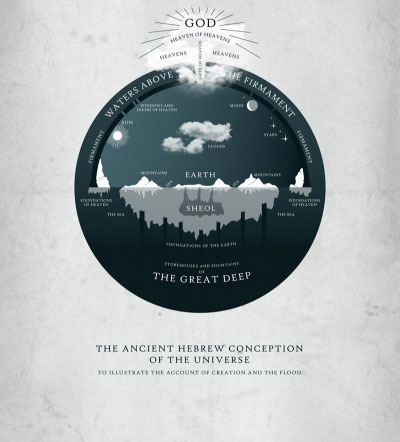
The Ancient Hebrew Conception of the Universe (All images by Michael Paukner) (Click Image to Enlarge)
 Michael Paukner
Michael Paukner’s infographics go beyond the usual function of the form: his original collection of posters titled “See The Bigger Picture” range from straight-faced renderings of crop circles and planetary “energy grid theory” to stunningly simple illustrations of the Pythagorean theorem or the mathematical golden ratio as expressed by planetary orbits.
The range is profound but the style remains the same: clean, elegant, and, above all, informative. But what Paukner chooses to inform us about is, more often than not, a piece of arcane legend or a pseudoscientific theory that few of us have ever heard of. Paukner explains, “It all began when a drunk guy behind a bar told me about Planet X and 2012 some years ago.… I bought some books and found some other topics like ancient knowledge, religion, old prophecies, crop circles, and other mind-blowing facts and theories. I started to feel like Fox Mulder, always searching for the truth out there.”
Several years later, Paukner’s Flickr page has registered millions of views in only six months, and he’s been the subject of features in several design magazines. Paukner is no stranger to fame — he’s also the lead singer of the popular Austrian band Excuse Me Moses, whose last album leaped to #13 on the Austrian charts — but the success of these graphics was very unexpected to him.
(more…)
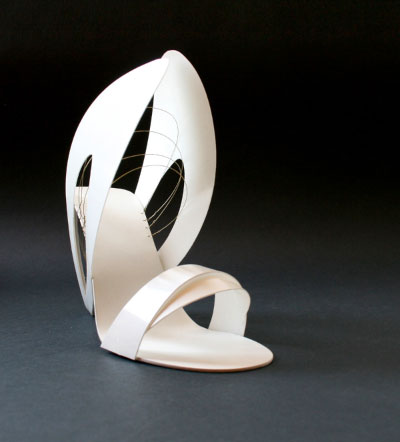

Coco Chanel was quoted as saying, “Fashion is architecture: it is a matter of proportions.” Sarajevo design student Tea Petrovic seems to have taken Coco’s statement to heart; for her graduating project, Petrovic designed a startlingly original collection of shoes based on the designs of the greatly influential Spanish architect Santiago Calatrava and the works of the late Russian Constructivist sculptor Naum Gabo. But Petrovic quotes another fashion designer in her statement, writing, “Bernard Figueroa once said: ‘There is so much space between a woman’s heel and the floor that one can use, and that is exactly what I tried to accomplish … using this space as much as possible.”
Discarding the fashion designer’s usual considerations of function and comfort, Petrovic focuses instead on the shoe as a pure geometric form, “rich in freedom and artistic expression”. She chose Gabo and Calatrava for their focus on figures “inspired mostly by nature, space, geometric shapes, and mathematical principles”.
The heel, specifically, is Petrovic’s focal point. To her, heels “are like supporting poles, constructive elements which carry the whole creative process”. Petrovic created the 3D heel shapes by multiplying, overlapping, and rotating 2D surfaces. The result is a series of exquisitely constructed sculptural works.
(more…)
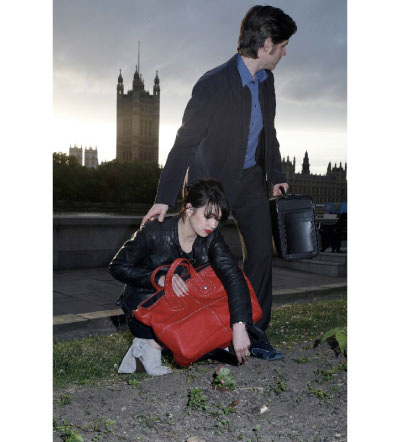

While the term “guerilla gardening” isn’t widely known, anyone off the street can likely recognize the name Johnny Appleseed. And the legendary Appleseed? Arguably America’s first guerilla gardener.
Guerilla gardeners are environmental activists who take neglected urban spaces — literally — into their own hands. Plots of dirt such as those surrounding trees on a sidewalk or at a highway median are dug up, seeded, and watered so that beautiful (and carbon-consuming) trees, plants, and flowers emerge in what was formerly an eyesore of urban neglect. Today, there are guerilla gardening subcultures active in major metropolises throughout Europe, Asia, the Americas, and Australia.
Vanessa Harden, an artist and active participant in London’s guerilla gardening scene, currently has an exhibition on display until March 21 at Salon Contemporary. Titled The Subversive Gardener, the exhibit features gardening tools that masquerade as such day-to-day items as purses, briefcases, oxford shoes, and even cameras. Inspired almost equally by spy gadgetry and biological systems such as seed dispersal, the items include the Mk II Agent Deployed Field Auger — a briefcase that conceals tools that can quickly drill holes in the ground — and the 2-round Tactical Gravity Planter — a purse that can hold two peat-potted plants on a built-in conveyor belt that easily drops them into their new homes.
(more…)
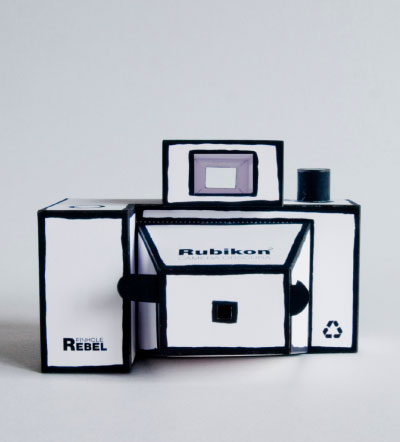

In the digital age, photographs are everywhere and all the world has a camera. At the same time, classical photography is being forgotten and, consequently, has become even more expensive as pixels replace actual film.
Here to remind us of photography’s most rudimentary origins is Czech designer Jaroslav Jurica and his “Rubikon Pinhole Rebel”. Published under a Creative Commons license in PDF format, anyone with access to the internet and a printer can print out and glue together the pieces to form a functioning pinhole camera.
A pinhole camera, whether made of paper or plastic, is essentially a hand-held camera obscura. Latin for “dark room”, the term camera obscura refers to the premodern discovery that when light was filtered into a dark room through a small aperture, images would be projected upside-down onto an opposing wall or screen. Aristotle, da Vinci, and Chinese and Arabic philosophers dating back to the tenth century B.C. understood and wrote about the phenomenon that laid the groundwork for modern image-making.
Thanks to the Rubikon Pinhole Rebel, three thousand years later the haunting, unexpected beauty of simple photography is made as easy for us to explore as it was for the ancients.
(more…)

Photography courtesy of © Jiri Rezac / WWF-UK (Click on Images to Enlarge)

While the world’s attention has been focused upon Canada for the Winter Olympics, another northerly site worth noting has continued to be widely ignored. Far from gold medal glory, the oil sands in northern Alberta continue to be dug up, mined, steamed, and refined in what many have claimed to be the most environmentally damaging process on earth.
The “tar sands”, as they’re most widely known, refer to bitumen (a dense, degraded form of oil) deposits that lie in the earth’s uppermost layers, heavily mixed together with sand. This form of petroleum is difficult to mine and even more difficult to refine into a usable form. The sands are such an expensive source of oil that it wasn’t until the 1990s that technology had advanced enough for the project to be economically viable. But with the reality of peak oil looming, the sands are now mined in earnest.
One million barrels are currently culled each day from the sands (of which 80 percent goes to the US) and each barrel requires cutting down forest, the removal of two tons of earth to reach the sands, and the removal of two tons of the sand itself. The whole process unleashes five times more greenhouse gases into the atmosphere than normal oil mining. Not only that, but barrels of water are used in the refining process to steam the bitumen from the sand, and the contaminated water left over is dumped into tailings ponds, which, as of a year ago, covered around 50 square miles.
(more…)





 Facebook
Facebook Permalink
Permalink Digg
Digg Reddit
Reddit LinkedIn
LinkedIn StumbleUpon
StumbleUpon Tumblr
Tumblr


